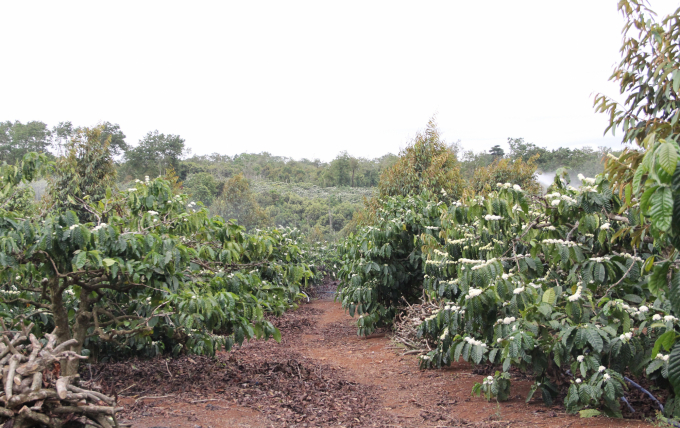The ‘magic’ of self-composting
(VAN) In order to reduce production costs and protect soil health, coffee farmers in Lam Dong have made
The persisting situation of agro-input prices constantly on the rise has been forcing many farmers to struggle. But thanks to the appearance of the coffee landscape model, many households can now reduce agro-input costs very effectively.
As one of the owners of the largest coffee garden of the Dak Nong Organic Agriculture Cooperative in Dak R'Moan commune, Gia Nghia city (Dak Nong), Mr. Pham Van Thach said that this year his coffee garden of 20 ha had had a high yield with an output of more than 3.5 tons per ha.
“My family develops and invests in the coffee garden while applying the coffee landscape model and organic standards. Members of Dak Nong Organic Agriculture Cooperative all build their coffee garden according to this model in the form of three-storey ecological garden. The high tree floor includes fruit trees and trees used to cover the sun, dew and wind to regulate the garden’s temperature, the middle floor is for coffee, and the lowest floor is for grass and vegetation.”
The organic landscape coffee model of Mr. Thach's family. Photo: Quang Yen.
Since the implementation of the landscape coffee model, people no longer use chemical pesticides and fertilizers in the garden. Instead they use microbial fertilizers or compost from goats, cows, and coffee husks processed into quality fertilizers for their crops. The local households also breed indigenous microorganisms to spray and irrigate the gardens.
“Thanks to these decisions, families in the cooperative can save up to 40% of investment costs,” said Mr. Thach.
The coffee landscape model with the three-storey ecological garden concept proves to be a success in other cooperatives as they all claimed to witness a vivid production cost decrease in the context of skyrocketing agro-input prices.
Cooperatives following the coffee landscape model all use compost to protect the soil and save costs. Photo: Quang Yen.
According to experts, the implementation of the coffee landscape model has contributed to reducing 14% of the amount of chemical fertilizers used, 17% of the irrigation water, 11% of production costs, and 10% of CO2 emitted into the environment. The coffee produced in pilot areas is 100% purchased at a price higher than the market average.
“Planting coffee according to the coffee landscape model helps the family's garden attain sustainable development. The annual output is satisfactory, the products’ selling price is higher than those acquired from traditional farming methods, so the people's income is always guaranteed,” said Mr. Pham Van Thach.
Not only coffee but Dak Nong Organic Agriculture Cooperative also follows organic pepper farming models. Thanks to applying production procedures according to organic standards, the price of products from these organic models is always superior to products in traditional gardens.
With evident benefits, the landscape coffee model will be a new direction for the agriculture industry.
Landscape coffee model intercropped with other trees can bring higher profits. Photo: Quang Yen.
Mr. Nguyen Duc Minh, a member of Ea Tan Cooperative, produces coffee using sustainable methods. After two years of applying the coffee landscape model, he has mastered the optimal tillage method, increasing the use of organic fertilizers and micro-organisms, and using grass to improve the soil quality. He has also received guidance on the techniques to intercrop different crops in the same unit area.
Changing the outdated farming habits and practices, implementing sustainable cultivation through landscape models may force him to further invest in other aspects and care for the crop in a more careful and meticulous manner, but in return, the yield and quality of coffee is higher while the list of output products are also more diversified, helping the family’s income increase significantly.
Mr. Y Giang Gry Nie Knong, Vice Chairman of Dak Lak Provincial People's Committee, said that the coffee landscape model was piloted in the two communes of Ea Tan and Ea To (Krong Nang district) with an area of 5,000 ha. But now, the figures have expanded fourfold: Krong Nang district has 20,000 ha of coffee produced following the landscape model.
Realizing the benefits of this model, Dak Lak assigned the Department of Agriculture and Rural Development to coordinate with relevant authorities and aim to replicate the coffee landscape model to more than 90,000 ha in the province.
Translated by Samuel Pham


